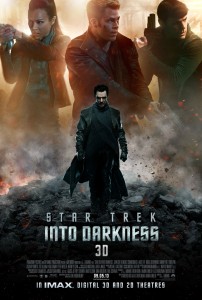Star Trek: Into Darkness
Posted on May 16, 2013 at 9:36 am
B+| Lowest Recommended Age: | Middle School |
| MPAA Rating: | Rated PG-13 for intense sequences of sci-fi action and violence |
| Profanity: | A few s-words and a couple of other bad words |
| Alcohol/ Drugs: | Drinking, bar |
| Violence/ Scariness: | Extensive sci-fi/action violence including acts of terrorism, characters injured and killed |
| Diversity Issues: | Diverse characters |
| Date Released to Theaters: | May 16, 2013 |
| Date Released to DVD: | September 9, 2013 |
| Amazon.com ASIN: | B00AZMFJYA |
This time, there’s crying in “Star Trek.” And some very significant time on Earth as well. This story is in the most literal sense, close to home.
Writer-director J.J. Abrams, who rebooted Gene Roddenberry’s original “Star Trek” saga with a rousing 2009 origin story prequel now takes us closer to the place where the original series began. There’s just a touch of the famous soaring theme song and some references the old-school Trekkers (don’t call them Trekkies) will love. A tribble plays a key role, and there’s a mention of a certain Ms. Chapel, who is studying to be a nurse. A character from the original series appears to give us some more of his backstory. And we get to hear Uhura speak Klingon.
But the primary focus is on the relationship between the main characters, Uhura (Zoe Saldana), Scotty (Simon Pegg), Bones (Karl Urban), and especially the cerebral half-Vulcan Spock (Zachary Quinto) and the impetuous Kirk (Chris Pine). We rejoin the story mid-chase on a remote planet with a massive volcano about to explode and the Prime Directive (the Federation observes and reports but does not interfere with other civilizations or alter their destiny, even by being seen by them) is about to be jettisoned once again.
As in the original series and its sequels, “Star Trek: Into Darkness” takes on moral dilemmas and geopolitical allegories with the same full-on gusto with which the characters engage with the adventures of the universe. The issue of the few weighed against the many and the personal connections weighed against the larger world (or galaxy) comes up several times, in increasingly complex variations. And, of course, there’s a ton of action.
It is impossible to say much more — including some minor quibbles — without some serious spoilers, though I will object to the under-use of the talented Alice Eve, who is playing a brilliant scientist but for no reason whatsoever has to appear in her underwear. As for plot, I will just say that a terrorist-style attack in London leads to an interplanetary chase into Klingon territory. But as so often happens in the allegorical Roddenberry universe that gives all of “Star Trek” its resonance, the real enemy may be ourselves. The performances are all superb, including Benedict Cumberbatch of the PBS series “Sherlock” bringing terrifying power and ferocity to the role of the villain with the English accent. They go where many, many men and women have gone before, but they do it right.
Parents should know that this film includes constant sci-fi/action violence including chases, explosions, fights, guns, terrorist-style attacks, characters injured and killed, brief disturbing images, some non-explicit sexual references and situation, drinking, and some strong language (s-words, etc.).
Family discussion: Several characters have to make choices about who is more important — the people they know or the larger group of strangers. What are some real-life situations where people have to make similar decisions? What factors should they consider? Why does Pike think that Kirk deserves a second chance? How do you know when to break the rules? Is it because there are other rules that are more important?
If you like this, try: the “Star Trek” movies and television series, the comedy “Galaxy Quest,” and the documentary “Trekkies”

